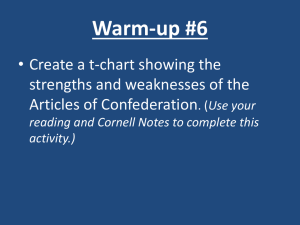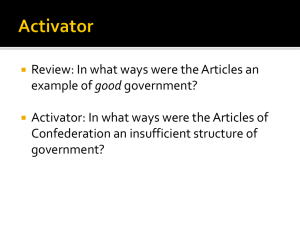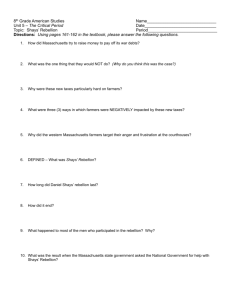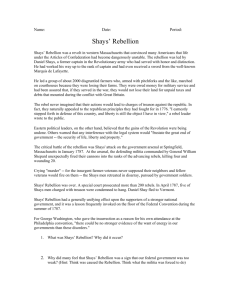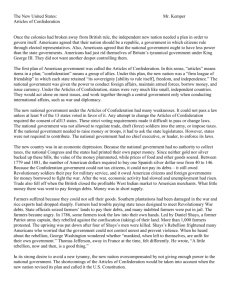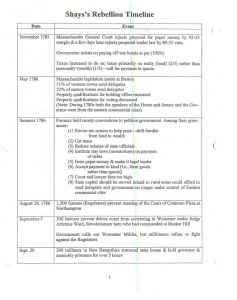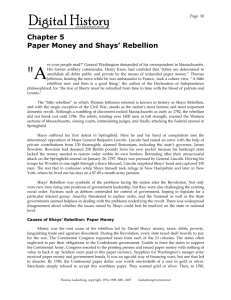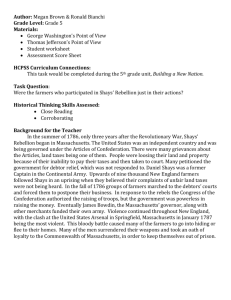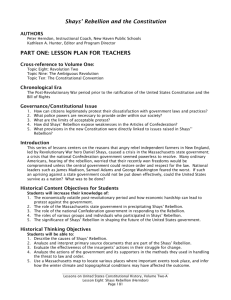Reading Handout: Shays` Rebellion
advertisement
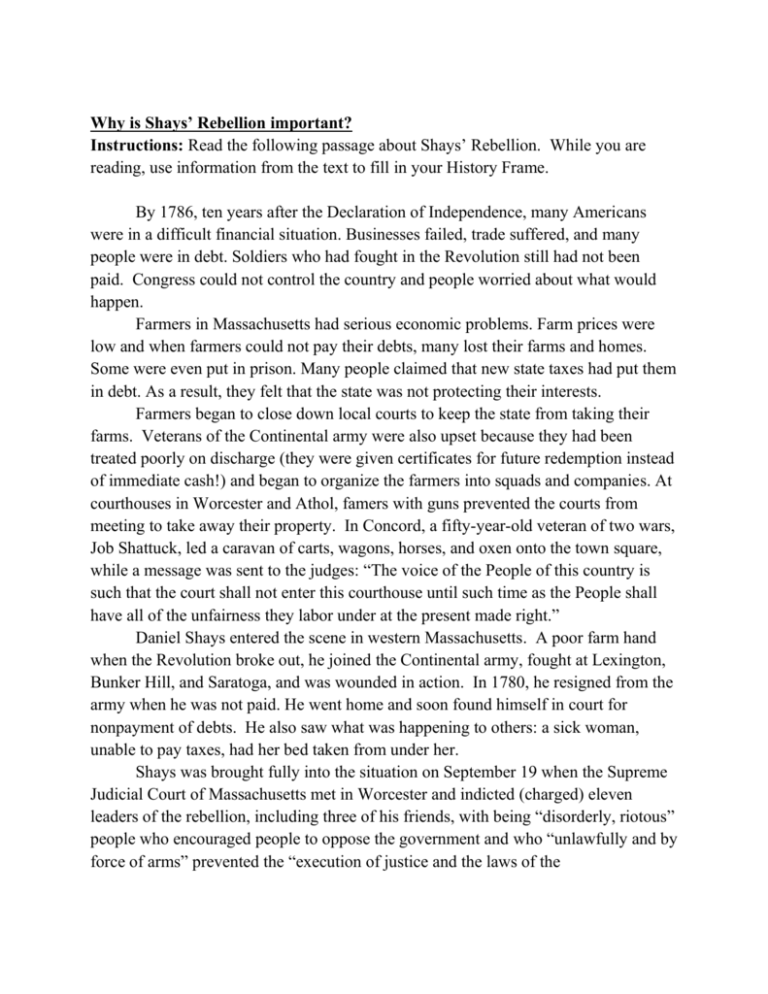
Why is Shays’ Rebellion important? Instructions: Read the following passage about Shays’ Rebellion. While you are reading, use information from the text to fill in your History Frame. By 1786, ten years after the Declaration of Independence, many Americans were in a difficult financial situation. Businesses failed, trade suffered, and many people were in debt. Soldiers who had fought in the Revolution still had not been paid. Congress could not control the country and people worried about what would happen. Farmers in Massachusetts had serious economic problems. Farm prices were low and when farmers could not pay their debts, many lost their farms and homes. Some were even put in prison. Many people claimed that new state taxes had put them in debt. As a result, they felt that the state was not protecting their interests. Farmers began to close down local courts to keep the state from taking their farms. Veterans of the Continental army were also upset because they had been treated poorly on discharge (they were given certificates for future redemption instead of immediate cash!) and began to organize the farmers into squads and companies. At courthouses in Worcester and Athol, famers with guns prevented the courts from meeting to take away their property. In Concord, a fifty-year-old veteran of two wars, Job Shattuck, led a caravan of carts, wagons, horses, and oxen onto the town square, while a message was sent to the judges: “The voice of the People of this country is such that the court shall not enter this courthouse until such time as the People shall have all of the unfairness they labor under at the present made right.” Daniel Shays entered the scene in western Massachusetts. A poor farm hand when the Revolution broke out, he joined the Continental army, fought at Lexington, Bunker Hill, and Saratoga, and was wounded in action. In 1780, he resigned from the army when he was not paid. He went home and soon found himself in court for nonpayment of debts. He also saw what was happening to others: a sick woman, unable to pay taxes, had her bed taken from under her. Shays was brought fully into the situation on September 19 when the Supreme Judicial Court of Massachusetts met in Worcester and indicted (charged) eleven leaders of the rebellion, including three of his friends, with being “disorderly, riotous” people who encouraged people to oppose the government and who “unlawfully and by force of arms” prevented the “execution of justice and the laws of the commonwealth.” The Supreme judicial court planned to meet again in Springfield a week later and there was talk of Luke Day, a leader of the dissenters, being indicted. Shays organized seven hundred armed farmers, most of them veterans of the war, and led them to Springfield to close down the court. Shays and his men moved through the square outside the court house, drums banging and fifes blowing. As they marched, their numbers grew. Some of the militia joined, and reinforcements began coming in from the countryside. The judges first postponed hearings for a day, and then suspended the court indefinitely. Having saved people’s lives and property by stopping court proceedings, Shays and his band of several hundred angry farmers then tried to capture the arsenal at Springfield. A place where all arms were kept for the state militia, Shays’ followers attacked the arsenal hoping to gain weapons they needed in their rebellion against the state government. This attempt to overtake the arsenal at Springfield failed when Shays’ forces were defeated by state troops in January 1787. While the leaders of the uprising were sentenced to death, in the end the state freed most of the rebels, including Shays. This uprising of farmers to protest high taxes and heavy debt led by Daniel Shays in western Massachusetts from 1786 to 1787 became known as Shays’ Rebellion. In the end, Shay’s Rebellion showed the weakness of the Confederation government. When Massachusetts had asked the national government to help put down Shays’ Rebellion, Congress could offer little help. Leaders were wanted who would be able to protect the nation in times of crisis. Although Shay’s followers had been defeated, the rebellion frightened many property owners. They feared that such actions might become widespread. It is this fear of future rebellions and the increasingly apparent weaknesses of the Articles of Confederation that led to the call for a new constitution with a strong central government. In 1786 Virginia invited all the states to send representatives to a meeting in Annapolis, Maryland to consider trade problems. When only five states sent representatives, the meeting sent a report to the Confederation Congress requesting a convention of all the states to revise the Articles. After much deliberation, Congress invited the states to send delegates to a convention in Philadelphia. It is at this convention that representatives would throw out the Articles of Confederation and create the new Constitution that we have today.
